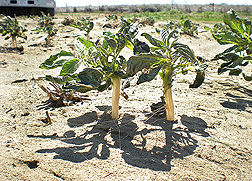This page has been archived and is being provided for reference purposes only. The page is no longer being updated, and therefore, links on the page may be invalid.
| Read the magazine story to find out more. |
|
|
|
|
Researchers Examine Way to Undercut Dust Emissions
By Don ComisJuly 14, 2011
There is literally a way to undercut dust emissions in the very driest parts of the Pacific Northwest's Columbia Plateau region, according to a U.S. Department of Agriculture (USDA) scientist.
Brenton Sharratt, research leader at the USDA Agricultural Research Service (ARS) Land Management and Water Conservation Research Unit in Pullman, Wash., found that undercutting is a promising conservation tillage technique on fallow fields. ARS is USDA's principal intramural scientific research agency.
An undercutter has wide, overlapping, V-shaped steel blades. Pulled by a tractor, the blades slice beneath the soil surface and gently lift and set down the uppermost layer in place. This severs weed roots without inverting the soil as a plow does.
Wind-blown soil particles or particulate matter less than 10 microns in diameter, known as PM10, are an air quality concern in the Pacific Northwest and other parts of the United States. Sharratt's experiments show that undercutting to a depth of 4 inches can reduce PM10 emissions by 30 to 70 percent compared to conventional tillage.
Dust storms also harm farm productivity.
Undercutting is one of many possible practices being identified by Sharratt as cost-effective ways to reduce wind erosion in the Columbia Plateau region. Both tillage and crop choices influence soil roughness, the size of soil clods, and the amount of post-harvest crop residue. The rougher the soil surface, the bigger the clods, and the more residue, the less susceptible the soil is to erosion by wind or water. Sharratt found that undercutter tillage creates an aerodynamically rougher soil surface and promotes retention of crop residue.
Read more about this research, which supports the USDA commitment to sustainable agriculture, in the July 2011 issue of Agricultural Research magazine.
Sharratt and Guanglong Feng, with Washington State University's Department of Biological Systems Engineering at Pullman, have published pioneering papers on this subject in the journals Soil & Tillage Research and Earth Surface Processes and Landforms.

